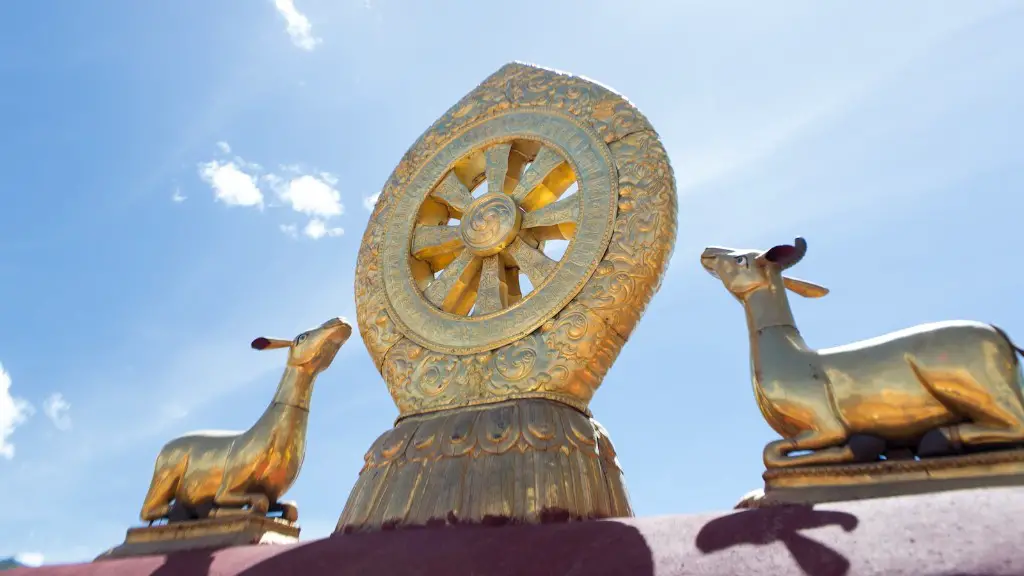Hinduism is a complex and ancient religion that has a system of beliefs and rituals and it has developed over centuries. It is one of the oldest spiritual traditions in existence and is still practiced today by millions of believers worldwide. In Hindu tradition, the four stages of life are called ashramas. This is an important concept which is central to understanding Hinduism.
The ashramas represent four distinct periods of life: student, householder, retired, and renouncing. Each ashrama is associated with certain goals and ideals which are used to guide Hindus in living a meaningful life. The four ashramas are Brahmacarya, Grihastya, Vanaprastha, and Sannyasa. Each meditating upon the different duties and responsibilities which Hindu’s are expected to abide by in their particular stage of life.
Brahmacarya is the student phase in which a Hindu youth enters his 12th year and is ready to start his spiritual journey. During this stage, one is supposed to live with a spiritual mentor and study religious knowledge from him. It is important to note that during this phase, a Hindu youth is also expected to practice celibacy and abstain from worldly pleasures. The main goal of this phase is to acquire spiritual knowledge and practice self-discipline.
Grihastya is the house holder phase in which a Hindu will have all the basic desires fulfilled. This phase is considered the most important part of a Hindu’s spiritual journey as it is the time in which a Hindu will experience all the basic pleasures such as material wealth, family life, and relationship (both between people and the Divine). During this phase, the main goal is to engage in spiritual practices and rituals in order to gain liberation from worldly desires.
Vanaprastha is the retired phase in which one begins to distance himself from the mundane world and turn his focus towards spiritual development. During this stage, a Hindu is supposed to practice self-control and restraint, and use his newfound spiritual knowledge to engage in meditation and contemplation. The main goal of this phase is to he is expected to subside all his desires and become detached from the material world.
Sannyasa is the renouncing stage in which a Hindu will transcend the material world and struggles. During this stage, the focus is entirely on God realization and the attainment of liberation. A Hindu will no longer have any worldly attachments and will strive to become one with the divine. The main goal of this stage is to live in harmony with nature and attain complete liberation.
Achievements In Each Stage
The four stages of life in Hinduism are not seen as rigid and fixed steps on a path, but rather as a structure in which to guide Hindus towards achieving a meaningful life. Through the four ashramas, Hindus are expected to achieve different levels of spiritual growth, but it is ultimately up to the individual to decide how much spiritual growth he or she desires and how much to pursue it. During Brahmacharya, the youth is expected to focus on acquiring knowledge and developing self-discipline, while during Grihastya, the individual experiences material wealth and fulfilling relationships. During Vanaprastha and Sannyasa, the focus shifts to providing spiritual guidance and achieving liberation.
Hindus are expected to find balance and harmony within each of the four Ashramas in order to experience a wholesome spiritual life. Every individual must make their own journey and find their own path to enlightenment. By following the duties and responsibilities laid out in the four Ashramas, one can gain a greater understanding of the world, and become closer to the divine. This can result in greater peace and harmony in life.
Rituals in Each Stage
Each stage of life in Hinduism is associated with certain rituals and practices which serve as a means of expressing devotion to the Divine. During Brahmacharya, the Hindu youth is expected to perform puja (rituals) to the deities, observe fasting and visit places of worship regularly. During Grihastya, regular observance of seasonal festivals and special occasions are practiced, and yagyas (sacrificial rituals) are performed. During Vanaprastha, practice of tapasya (austerities) and vratas (observances) are done in order to renounce worldly desires. In Sannyasa, the renouncer devotes all his time to meditation and contemplation in order to attain closer proximity to the divine.
Benefits of the Four Stages
By following the four stages of life in Hinduism, individuals can gain a greater understanding of their relationship to the Divine, as well as their own lives in general. It also provides them with a greater sense of purpose, as it teaches them to focus their energy on connecting with the divine and pursuing spiritual growth. Additionally, following the four stages also provides a sense of stability and security, as one can always rely on the structures provided to guide their lives, and there is no need to deviate from them in order to gain spiritual progress.
Furthermore, by following the four stages, individuals can gain insight into their spiritual path, as the phases provide markers for spiritual development. They act as a reminder of what one can strive for, and enables them to track their spiritual progress. In this way, the four stages serve as a compass for attaining spiritual growth and enlightenment.
Observances of the Four Stages
The observance of the four stages is not a compulsory practice in Hinduism, but it is certainly encouraged. While one is not required to go through each stage in strict chronological order, it is still seen as an important part of spiritual growth. As such, it is recommended that individuals observe the duties and responsibilities associated with each stage of life, in order to ensure that they reach their spiritual goals and have a meaningful life.
While the four stages of life provide a structure for spiritual development, it is ultimately up to each individual to decide which path to pursue and how far along the path they want to go. The four stages are simply a framework in which to guide individuals to a greater understanding of their spiritual journey and the divine. By following the four stages of Hinduism, one can gain insight into their relationship to the divine and engage in meaningful spiritual practices that lead to greater peace and enlightenment.
Relevance To Modern Life
The four stages of life in Hinduism remain relevant to our modern-day lives, as they can provide individuals with the structure necessary to pursue their spiritual goals. By following the duties and responsibilities of each stage, one can gain a greater understanding of their relationship with the divine and live a meaningful life. Additionally, they can also serve as a reminder of their own spiritual progress and provide them with the assurance that they are on the right path. Ultimately, the four stages of life in Hinduism serve as an important framework for anyone seeking spiritual growth.
Reflection and Conclusion
In conclusion, the four stages of life in Hinduism are an integral part of the spiritual journey and provide a useful framework for individuals to guide their own spiritual growth. By following the duties and responsibilities associated with each stage, one can gain insight into their relationship with the divine and learn to live a meaningful life. By reflecting on the observances of the four stages, individuals can gain a greater understanding of their spiritual progress and ensure that they are engaging in meaningful practices that lead to greater peace and harmony.

